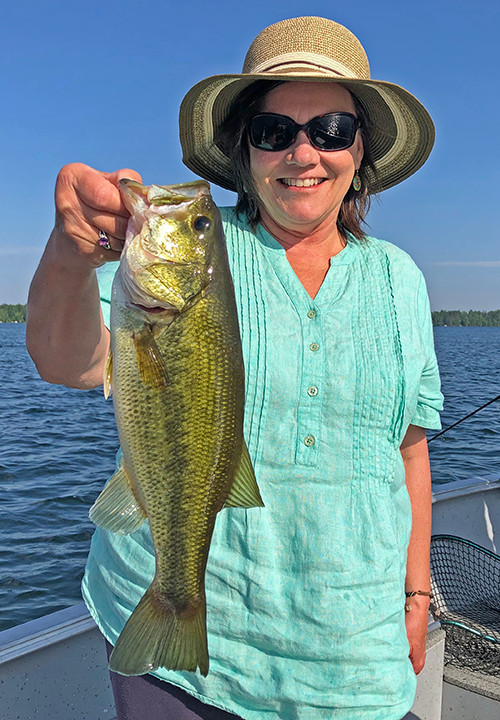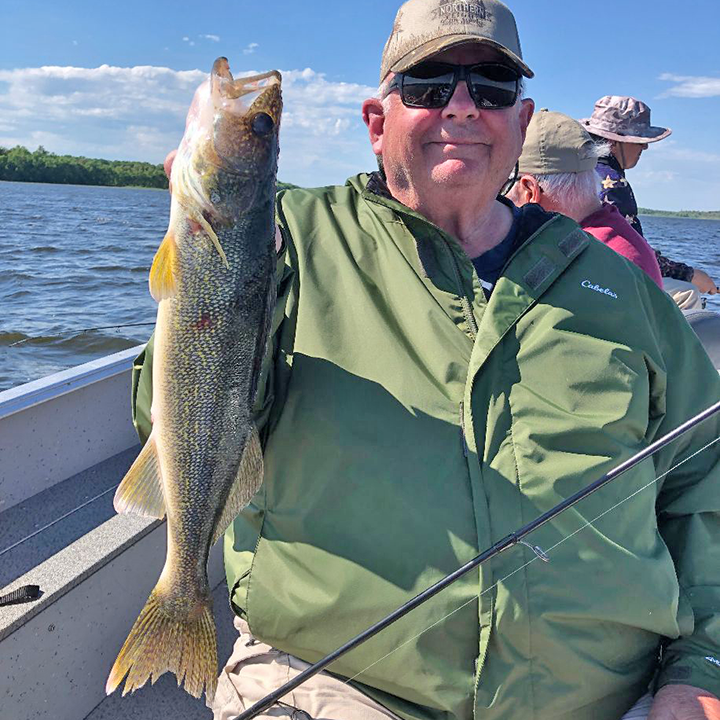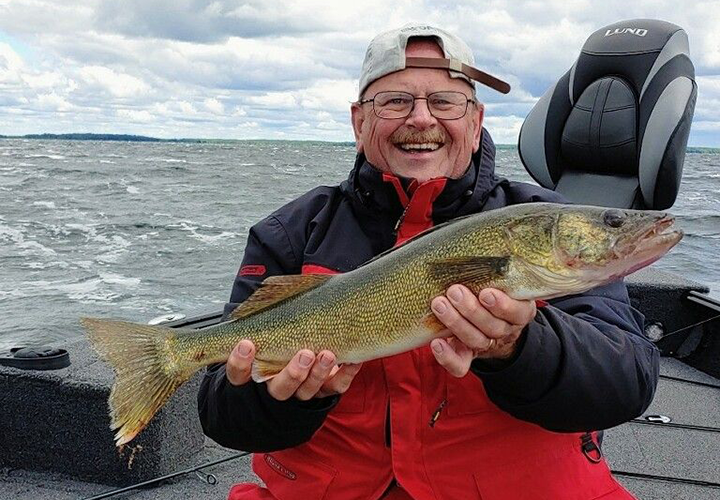Surface water temperatures on Cutfoot Sioux Lake are warm, ranging from 77 to 81 degrees, depending on the breeze. Algae blooms, triggered by weeks of warm, sunny weather are helping to darken the clear water and lush vegetation provides shade for fish in the shallows. When you combine these ingredients, along with shoreline trolling patterns, you can count on an action bite that leads to a mixed catch of walleye, crappie, sunfish, perch, and northern pike.
Algae Blooms developing on both Cutfoot Sioux and Lake Winnie
“Die hard” anglers can still catch fish under the warm sunshine, but most folks can get all the action they need by making short morning and evening fishing excursions. For many, midday is a time better spent on the beach, or playing on the lake with family and friends.
The grass lines in Cutfoot are green and they are thick, mostly growing out to depths of 8 to 10 feet of water. Some vegetation, depending on which type, may grow a little deeper than that, coontail for example, can be found in water depths of 16 to 20 feet. Those deeper patches of coontail should be explored for crappies, while the shallower stands of grass will hold more variety. For walleye, sunfish and pike, cabbage patches should get the larger portion of your attention.
Trolling spinners is the most popular mid-summer presentation on Cutfoot Sioux. But casting spin-jigs, especially during low-light hours can be a blast. Beetle Spins and Road Runners are popular, but virtually any jig head can be converted to a spin-jig by adding a Lindy Spinner. Jigs tipped with plastic tails will get some attention too. Experiment with 1/16-to-1/8-ounce jigs, adding paddle tails, shad imitators or even simple twirl tails. Cast the edges of the grass line and retrieve using a swim-drop-swim action, fish will most of grab the lure while it falls, so always keep a tight line!
Cutfoot Sioux offers great fishing for largemouth bass
Bass anglers are finding them in the heavier, shallower vegetation. Use weedless rigs like plastic worms, jig and pig, or swim baits to explore bulrushes, wild rice, lily pads and heavy patches of coontail and pondweed. The bass will be found in small pockets or openings located with the dense cover. You will need heavier gear, 12-to-20-pound test line and a medium-to-medium heavy rod to pull them out, but you’ll have a great time doing it.
Northern Pike haven’t gotten as much attention as they used to, but they should. There are a lot of pike in the system right now and because of the 22-to-26-inch protected slot, many of them are reaching larger sizes. Catching fat, 24-to-26-inch pike has become common, and there are more fish over the 26-inch threshold being caught these days too. Pike are not only fun to catch, they are good to eat and a few years back, Kurt Walbeck came up to produce a video about catching, cleaning and cooking them. Even if you’ve already seen it, now could be a good time for a refresher course on pike.
Click Here To >> View Outdoor Bound TV Northern Pike on Lake Winnie
Pike Anglers with catch from Lake Winnie courtesy Gerry Albert
Anglers heading out onto Big Winnie are reporting mixed results these days. Daytime fishing, they believe, is hampered by the calm, sunny seas and clear water. But for anglers in the know, nothing can be further from the truth. Walleyes, perch, pike and rock bass are active, even during the daytime, but first you’ll have to find them. Looking for them in deep water is the most common mistake anglers are making out there, the best success is being found by anglers fishing in 10 feet of water, or less.
Warm water temperatures, decent algae blooms, and high concentrations of 2018–2019-year classes of fish are fueling the shallow water bite. Weed patches and rocks are the primary structures holding fish, but they can be located on shoreline related breaklines too. The breaklines are not terrific spots for calm days, but when the wind blows and the current flows, fish will begin moving along them. One lesson learned during the 2020 fishing season was that fishing the shallow breaklines during late summer turned out to be very productive.
While no 2 years are ever the same, it does appear that we are on the same, or similar trajectory this summer. Both perch and pike were found in water depths of 5 to 7 feet on a breezy, overcast day late last week. Walleyes, roaming the edges of shallow water rocks were active this weekend. Some customers fishing with local guides had good success and reported bag limits of 2018 year class walleyes, size ranging up to and including 15 inches. With strong growth rates, we should be seeing lots of fish over 15 inches as we roll into the late summer, early fall fishing seasons.
Right now, trolling spinners is the most popular shallow water presentation. Gold, chartreuse, green and bright red spinner blades are good, the #3 Indiana size is most popular, and a 2/0 Aberdeen hook gets the nod from most of the guides and better anglers on the lake. Tip them with night crawlers or leeches if you like but check with many of the guides and you will find that a bucket full of fatheads is what most of them are carrying in their boats. Tailor the sinker weight to your specific depth range, 1/8-ounce bullet sinkers are good for water depths of 4 to 6 feet, 3/16-ounce bullets are good from 7 to 10 feet. Deeper than 10 feet, explore other sinker options like bottom bouncers or Lindy’s No Snagg sinkers.
Lake Winnie Jumbo Perch
Most often, perch, pike and rock bass are encountered by anglers trolling primarily for walleye. Once located, targeting them most efficiently could require adjustments to your presentation. Perch can be caught using jig and minnow combinations, so can rock bass. Pike, especially larger ones can be targeted effectively by casting large spinner baits, spoons and jerk baits.
Don’t overlook soft plastic for pike, large swimbaits like YUM’s Money Minnow produce very well. When all else fails, large minnows suspended below slip floats are fantastic too. An 8-to-12-inch sucker or creek chub wiggling below a bobber will attract and catch pike and can be used either while drifting the breaklines or fished from a stationary position.
This is the time of season when many of our guests could be described as “casually interested” in fishing. Many focus their attention on family activities, beating the heat at the beach or only plain relaxing. If fishing is not your primary concern, don’t worry, there’s still plenty to do, the water is warm, the surface is calm; conditions are perfect for playing on the lake!















